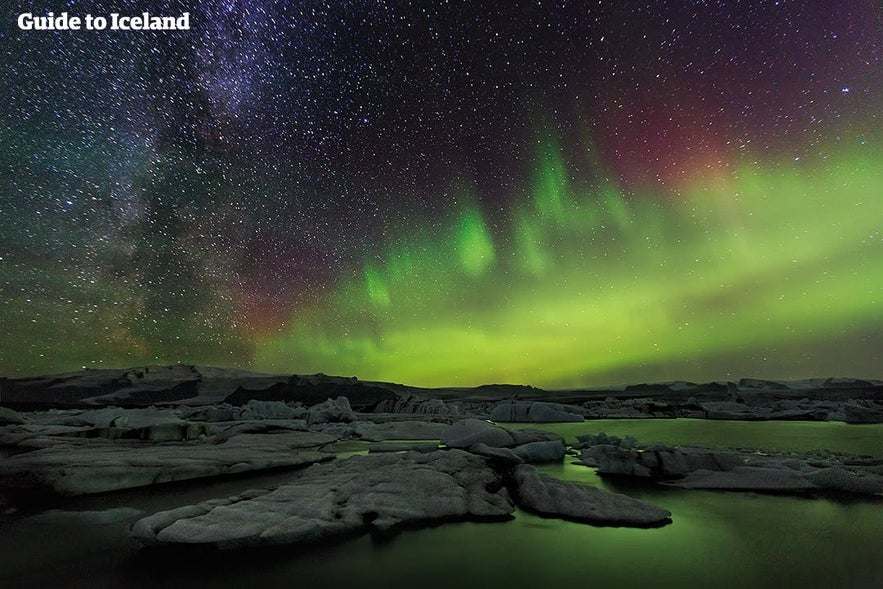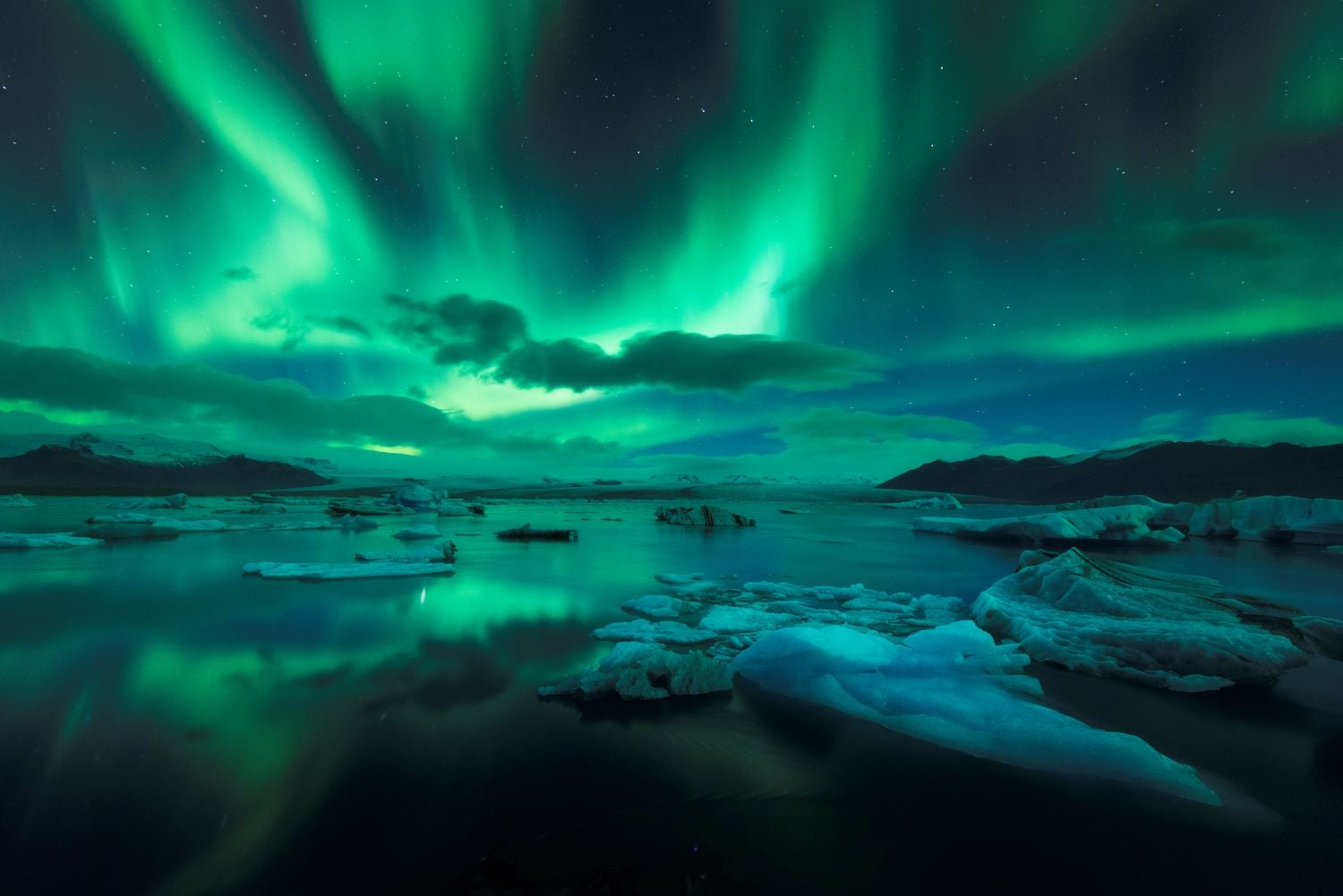Discover everything you need to know about the northern lights in Iceland with these FAQs. Get answers to the most common questions travelers ask, from the best months to spot the aurora borealis to tips on how to make the experience unforgettable.
The northern lights are one of Iceland’s most alluring and elusive attractions. Beyond the thrill of seeing them dance across the night sky, they are also rooted in centuries of science and folklore.
Why You Can Trust Our Content
Guide to Iceland is the most trusted travel platform in Iceland, helping millions of visitors each year. All our content is written and reviewed by local experts who are deeply familiar with Iceland. You can count on us for accurate, up-to-date, and trustworthy travel advice.
On dark winter nights, the sky can glow with sweeping bands of green, purple, and red. You can learn about the different types of aurora and discover expert tips on how to photograph the northern lights so you can capture your memories.
With the sun at peak activity, 2025 and 2026 are set to bring some of the brightest aurora displays in years. The most reliable way to see them is by staying at northern lights hotels in Iceland or joining guided northern lights tours that travel far from city lights for the clearest skies.
Keep reading for answers to the most asked questions about the northern lights in Iceland. Get ready to be inspired to plan your own aurora adventure!
-
Get to know more about the aurora by reading Northern Lights in Iceland
The Northern Lights | Iceland's Cosmic Treasure

If there’s one surefire way of putting life into perspective, it’s to look upon the northern lights. This spectacular solar phenomenon is truly one of nature's greatest wonders, creating ethereal lights in a range of colors that dance and swirl across the night sky.
These apparitions have only recently been understood by modern science, though they have long fascinated those who have seen them. Incredible myths and tales inspired by them are woven into the cultural fabric of many societies, and Iceland is no exception.
As such, witnessing the aurora borealis tops the bucket list of many travelers to Iceland. Inspired by incredible aurora photographs, thousands flock to Iceland each year. Travel bloggers often describe the northern lights as a “must-see,” and many regard them as one of nature’s most sought-after phenomena.
- See also: Top 12 Things to Do in Iceland
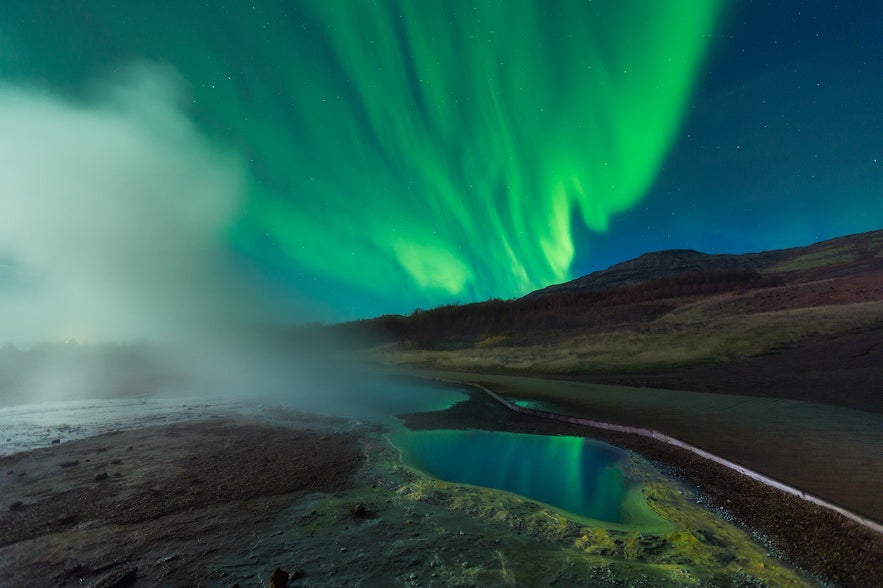
Even so, many guests come to Iceland with illusions about northern lights hunting that are not true. Every summer, some arrive shocked to find that the sun never sets in this season, thus the auroras are not visible. During a warm winter night, some will not set out under the misconception that the northern lights only appear when it's cold.
Many will fail to see them by remaining in Reykjavik, where light pollution often makes them invisible.
Before arriving in Iceland for a northern lights holiday, it's important to know when to come and what sort of tours to book. By planning well, you can maximize your chances of seeing the northern lights experience you won't forget.
Taking such steps will also protect you from unnecessary disappointment on arrival. They help you prepare for the chance that the aurora might not appear on your first hunt or that the display could be brief and faint. After all, the northern lights are a natural occurrence that depends on conditions far out of anyone's control.
Furthermore, a greater understanding of this phenomenon will only add to your experience. While any sighting of the northern lights is touching and magical, having background knowledge of the historical, cultural, and scientific role that this wonder has had across the world will make your celestial experience that much more special.
Frequently Asked Questions About Northern Lights
Below are clear answers to the questions travelers ask most about Iceland’s northern lights, including when and where to go, how to read forecasts, and what to wear
Are the aurora borealis and the northern lights different?
The northern lights and aurora borealis refer to the same amazing natural wonder; the latter term is simply the scientific name. The word Aurora is Latin for sunrise, and the name of the Roman Goddess of the dawn, and Borealis is the Greek name for the north wind.
Of course, they are called the 'Northern' Lights as they only occur in the Northern Hemisphere, usually (but not exclusively) above a latitude of 60 degrees. Iceland sits roughly between 64 N and 66 N. The southern lights are a similar phenomenon in the Southern Hemisphere and are called the aurora australis.
What is the role of the northern lights in mythology?
Long before the dawn of modern science, the world’s ancient peoples looked to the glittering night sky with big, existential questions. Without an understanding of even basic astronomy, physics, or geography, their relationship with the universe was very different from what is considered rational today.
From this lack of understanding came myths across many cultures, all tied to what was collectively shared: the movement of the stars. These myths gave rise to value systems and traditions – a means of interpreting and understanding mankind’s place in the cosmos.
- See also: Folklore in Iceland
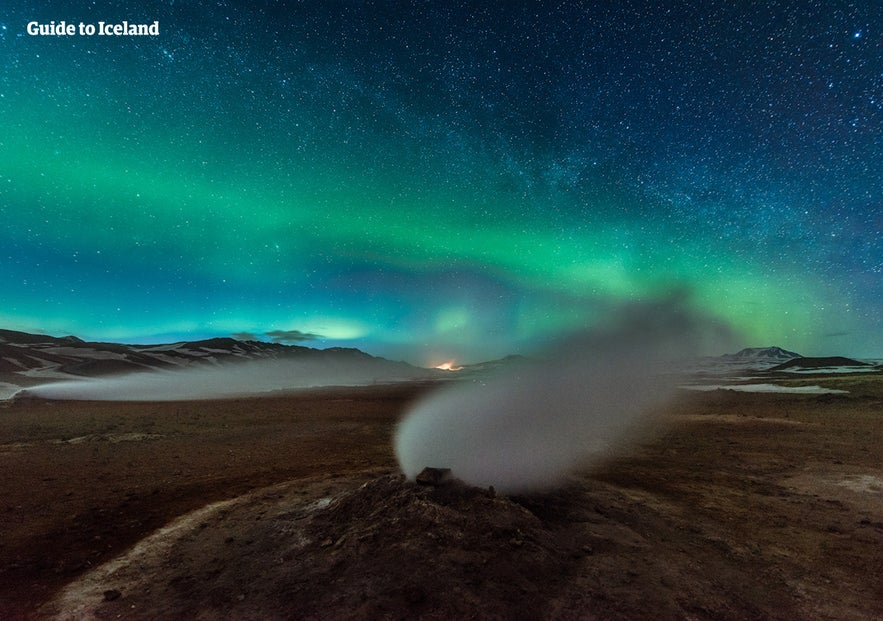
Wherever they occurred, the northern lights, including in Iceland, played a starring role in these beliefs. The Chinese, who rarely saw the aurora borealis, believed the lights were a battle between two dragons. Some Inuit groups in North America thought they were a ball game played by the spirits of their ancestors.
The Scottish, Irish, English, and French saw the northern lights as a warning of trouble ahead. In contrast, the Scandinavians believed they promised good fishing, easy childbirth, and warmth.

Many Greenlanders, rather morbidly, considered the lights to be the souls of dead children. The Finnish thought them either the glowing streak of a firefox or the magical spume of water ejected from a whale. The Cree Indians believed them to be a reflection of the life cycle, an image of their ancestors dancing in the heavens; the brighter they were, the happier their ancestors.
- See also: Vikings and the Norse Gods
Icelanders believed the lights to be about childbirth, too. Women in labor were told not to look at the northern lights as they gave birth for fear that the child would be born cross-eyed. However, due to their Scandinavian origins and their original belief in Norse Mythology, Icelanders also saw them as promising omens and held them in high spiritual esteem.
What color are the northern lights?
 The most common color of the northern lights in Iceland is fluorescent green, followed by pink and purple, then many shades of red, pink, blue, yellow, and orange. The color depends on what kind of particles are ionizing in the atmosphere; oxygen creates green and red lights, nitrogen creates pink and blue lights, and neon turns them orange.
The most common color of the northern lights in Iceland is fluorescent green, followed by pink and purple, then many shades of red, pink, blue, yellow, and orange. The color depends on what kind of particles are ionizing in the atmosphere; oxygen creates green and red lights, nitrogen creates pink and blue lights, and neon turns them orange.
What creates the northern lights?
 The northern lights happen when particles from the sun crash into Earth’s magnetic shield, called the magnetosphere. This shield protects us from harmful radiation, but it also guides the particles toward the North and South Poles, where they fall into the upper atmosphere.
The northern lights happen when particles from the sun crash into Earth’s magnetic shield, called the magnetosphere. This shield protects us from harmful radiation, but it also guides the particles toward the North and South Poles, where they fall into the upper atmosphere.
When these solar particles hit atoms and molecules high above Earth, they make them glow. This is what creates the colorful lights we see dancing across the sky.
When do the northern lights occur?
 The northern lights actually occur year-round; however, the overwhelming light of the sun makes them impossible to see during the day. Because Iceland experiences the midnight sun in June and July (and very bright evenings in May and August), the best time to see auroras here is between September and April when nights are dark. Northern lights tours in Iceland are only operated during these aurora season months.
The northern lights actually occur year-round; however, the overwhelming light of the sun makes them impossible to see during the day. Because Iceland experiences the midnight sun in June and July (and very bright evenings in May and August), the best time to see auroras here is between September and April when nights are dark. Northern lights tours in Iceland are only operated during these aurora season months.
Does it have to be cold to see the northern lights in Iceland?
 One of the most common questions northern lights guides receive is: “How cold does it have to be to see the northern lights?” In truth, temperature has absolutely no effect on whether the aurora appears – they simply require dark winter skies to be visible
One of the most common questions northern lights guides receive is: “How cold does it have to be to see the northern lights?” In truth, temperature has absolutely no effect on whether the aurora appears – they simply require dark winter skies to be visible
In fact, the warmer the weather, the more comfortable your aurora-watching experience will be. Many tour operators even provide hot cocoa on cold nights. During early spring (April) and early autumn (September), you can sometimes enjoy an incredible aurora display in relatively mild evening temperatures, often around 41–50 F (5–10 C).
Where can I see northern lights in Iceland?

You can see the northern lights anywhere in Iceland so long as the sky is dark and, as importantly, clear of clouds. This is because the auroras occur in the thermosphere layer of our atmosphere, 62 miles (100 kilometers) above sea level, which is far higher than any cloud.
Of course, some places around the island are more likely to provide a magnificent show. Firstly, anywhere rural is better than anywhere urban; street and residential light pollution will significantly reduce your chances of seeing the northern lights, particularly in Reykjavik.
Even if you can see the aurora borealis from your hotel window or a beer garden, they will appear much more dramatically if you can get somewhere darker. If you wish to see the lights without leaving the city, then it is recommended to go to one of the capital's less residential areas.
Anywhere in nature presents an equal opportunity to see the lights whenever it is dark, but of course, the further north you travel, the longer the nights. The South of Iceland is dark for 20 hours a day in midwinter, while the North is dark for about 22. The Northeast of Iceland, it should be noted, also experiences the least cloud cover out of any region on average.
Can I see the northern lights in Reykjavik?
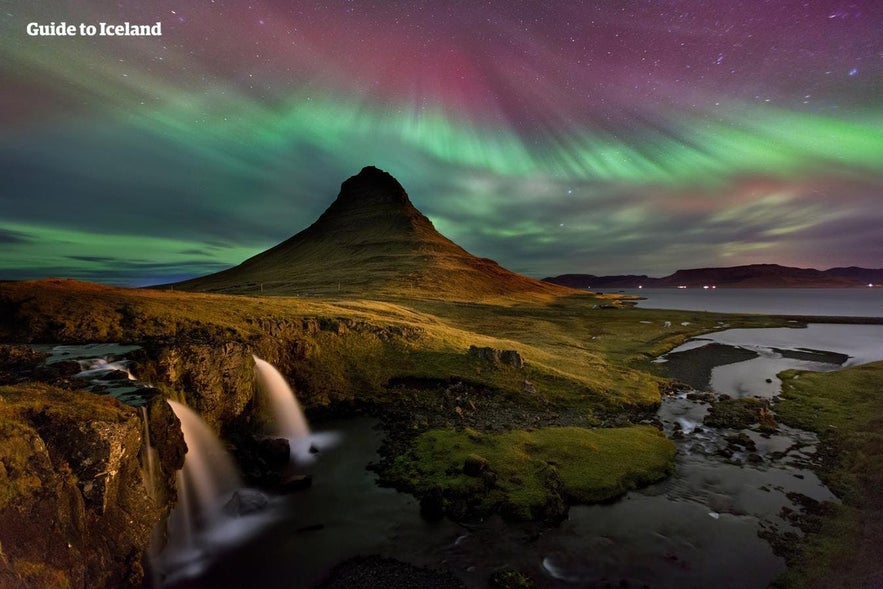
Open areas like parks or the coast, such as around the Grotta nature reserve, can provide darker settings for viewing. For the best experience, consider heading to the outskirts of Reykjavik, where darker skies offer a more vivid and unobstructed display.
For an alternative northern lights experience in Reykjavik, you can visit the Perlan Museum to see the mesmerizing Northern Lights Show. Alternatively, to learn more about how the aurora works, you can pair a northern lights tour with a visit to the Aurora Museum.
What's the best place to stay to see the northern lights in Iceland?
 If you want to see the northern lights from the comfort of your accommodation in Iceland, it's best to stay in more remote places. If you have a rental car, then staying in an Icelandic cottage can be great. You'll be more isolated from light pollution, and you'll enjoy total peace.
If you want to see the northern lights from the comfort of your accommodation in Iceland, it's best to stay in more remote places. If you have a rental car, then staying in an Icelandic cottage can be great. You'll be more isolated from light pollution, and you'll enjoy total peace.
There are also many hotels that have very little light pollution. You can find great accommodation along the Golden Circle, for example, or along the South Coast.
If you prefer to stay closer to Reykjavik, look for accommodation in the greater Capital Region, such as a hotel in Hafnarfjordur. This will provide easier access to more dark locations outside the city limits.
- Read more: The Best Northern Lights Hotels in Iceland
When is the best time of night to see northern lights in Iceland?

Of course, it is clear by now that you have to wait for a winter night to see the northern lights. There are also a few other considerations for those dedicated to witnessing the phenomenon. The best nights for aurora hunting, for example, are during a new moon; even a full moon can cause too much light pollution if the auroras are faint.
Due to atmospheric conditions, it is often said that the northern lights are usually at their best between 21:00 and 01:00. However, this is not always the case, and you should not discount a chance to see the lights if the opportunity arises outside these times.
Where else do the northern lights appear?

The northern lights can easily be seen from Alaska, Canada, Greenland, Norway, Sweden, Finland, and northern Russia. During geomagnetic storms, the auroras are also visible in lower altitudes, such as in some Baltic states, the British Isles, the rest of the USA, and China.
Due to its long dark nights, excellent infrastructure, remote nature, and somewhat manageable winter weather, Iceland remains one of the most easily accessible and reliable places to visit to see the aurora borealis.
- See also: Guide to Greenland
What is the best way to see the northern lights in Iceland?

The northern lights can be experienced in many ways in Iceland. Though, as mentioned, they can occasionally be seen from Reykjavik, those dedicated to witnessing the best possible display will find much better luck by considering one of the following options.
Firstly, it is more than possible for you to rent a car and drive out into Iceland's nature for your chance of catching a show. Using the cloud cover forecast and aurora forecast on the Icelandic meteorological office’s website, you can make the most of modern technology to plan the most promising trip.
If you choose to take this option between October and the beginning of April, it is highly recommended to rent a four-wheel drive due to the ice and snow on the roads, and only then for drivers confident in winter conditions.

While driving yourself allows you to search for as long as you like without worrying about other guests, you miss out on the expert knowledge of a local on a guided northern lights tour. These northern lights experts know all the best viewing spots and can help with camera settings to take the perfect photo. They can also answer any questions you have about the auroras themselves, the sites you visit, and Icelandic culture.
Most northern lights tours are conducted in buses, although there are super-jeep tours for those who want a smaller group and the chance to get even further into the landscapes. More unconventionally, you can take a northern lights cruise from Reykjavik to witness the marvelous spectacle from the open seas. In the North, you can even combine northern lights with a whale-watching tour from Akureyri.

The most reliable way to see the northern lights in Iceland, however, is to book a guided winter package or winter self-drive; both of these options will allow you to access remote parts of the country, allowing you to aurora hunt almost every night in incredible landscapes under near complete darkness.
This 5-day winter northern lights package, for example, will not only allow you to seek the aurora dancing above incredible sites such as the Jokulsarlon glacier lagoon, but will also introduce you to the ethereal crystal blue ice caves, rare features so beautiful it seems that they were drawn from a fable.
Those seeking the winter adventure of a lifetime, meanwhile, could look at this 15-day Iceland winter tour package, which not only takes you to all the sites above but also around theRing Road encircling the island, including the Snaefellsnes peninsula. Of course, on this epic journey, you’ll have fourteen nights to seek out the auroras.
If you would rather drive yourself, this 5-day northern lights self-drive and this 15-day winter self-drive are fantastic options that follow similar itineraries.

By booking a guided package or self-drive, you will have all your accommodation and tours booked in advance, allowing you to truly marvel over the amazing nature of Iceland and focus your energy on seeking out the incredible aurora borealis.
How can I check the northern lights forecast?
 The easiest way to check the northern lights forecast in Iceland is on the Icelandic Met Office website. Their map shows two things:
The easiest way to check the northern lights forecast in Iceland is on the Icelandic Met Office website. Their map shows two things:
- Aurora activity on a scale from 0–9 (called the Kp index). In Iceland, a Kp 2–3 can already give a good display, while a Kp 5 or higher often means a powerful show.
- Cloud cover, since clear skies are just as important as strong aurora activity. On the map, green areas mean clouds and white areas mean clear sky. Always look for the white patches.
For real-time tracking, many aurora watchers also follow a measure called Bz. When Bz turns southward (negative), it usually means the aurora is more likely to appear soon. Apps and websites often show this alongside the Kp index.
You can also use the OVATION model, updated every few minutes, which gives a short-term forecast of where auroras are likely to appear. Many aurora apps include this.
Finally, download an aurora app that sends alerts when conditions look good. These apps combine space weather and cloud forecasts, so you don’t miss sudden activity. Still, the best rule is simple: check the forecast, head to a dark, clear spot, and be patient.
How do I prepare for a northern lights hunt?
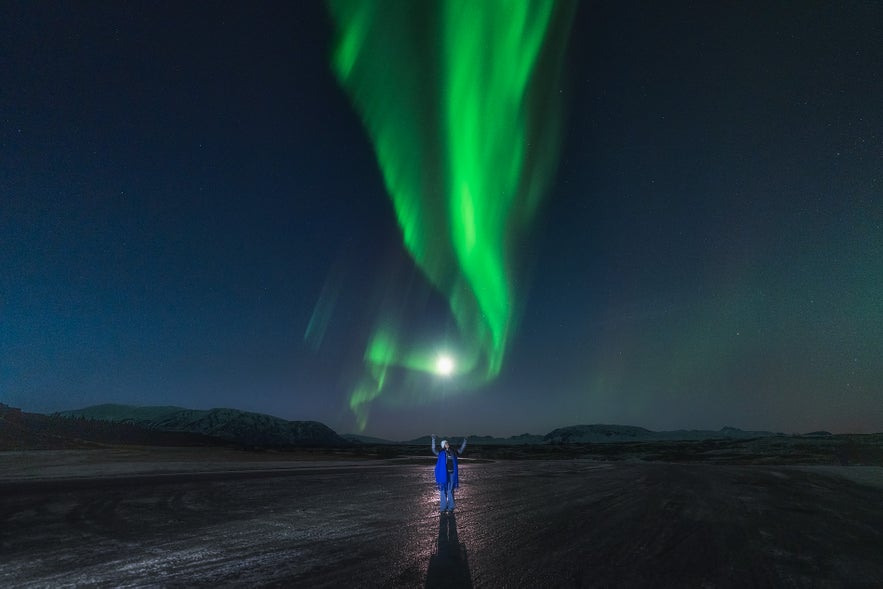 Preparation is key to a successful northern lights hunt. Begin by checking the aurora forecast to determine the likelihood of their occurrence, keeping an eye on solar activity levels and cloud cover. Ensure your transportation is ready, whether it’s a rental car or a guided tour.
Preparation is key to a successful northern lights hunt. Begin by checking the aurora forecast to determine the likelihood of their occurrence, keeping an eye on solar activity levels and cloud cover. Ensure your transportation is ready, whether it’s a rental car or a guided tour.
If you want good photographs, prepare your camera and ensure it has manual settings. Also, bring a sturdy tripod for stability during long exposures. Charge all batteries, and bring extras due to the cold weather’s draining effect.
Familiarize yourself with your camera's settings to quickly adjust in the dark. You may also want to bring a thermos with a warm drink to help keep yourself warm.
What should I wear for hunting the northern lights?
 When you go northern lights hunting in Iceland, you'll be standing outside for long periods of time. Dress warmly and in layers to adapt to the cold night. Insulated, thermal clothing, a windproof and waterproof outer layer, a hat, good gloves, and a scarf are essential to keep warm.
When you go northern lights hunting in Iceland, you'll be standing outside for long periods of time. Dress warmly and in layers to adapt to the cold night. Insulated, thermal clothing, a windproof and waterproof outer layer, a hat, good gloves, and a scarf are essential to keep warm.
Choose sturdy, waterproof boots for comfort and warmth, and wear wool or thermal socks. The key is to protect yourself from the cold, wind, and moisture while waiting for the lights, ensuring a comfortable and enjoyable experience.
- See also: What To Pack for Iceland for All Seasons
Why are 2025 and 2026 great years to see the northern lights in Iceland?
 If you’re planning an aurora-focused trip in the next couple of years, you’re in luck. The sun follows an 11-year cycle of activity, and the peak occurred in mid-2025. In fact, the current Solar Cycle (number 25) is expected to peak between late 2024 and early 2026, according to NOAA, during which northern lights activity will be heightened.
If you’re planning an aurora-focused trip in the next couple of years, you’re in luck. The sun follows an 11-year cycle of activity, and the peak occurred in mid-2025. In fact, the current Solar Cycle (number 25) is expected to peak between late 2024 and early 2026, according to NOAA, during which northern lights activity will be heightened.
This is the peak of the solar cycle, and scientists think it could be stronger than the last one in 2013–2014. A powerful solar maximum means more solar flares and eruptions, which create brighter auroras on Earth. In late 2024 and into 2025, people around the world have already seen unusually widespread northern lights because of this heightened activity.
For travelers to Iceland, 2025 and 2026 present a golden opportunity to chase the lights. Long winter nights combined with an active Sun mean auroras are more likely and potentially more vibrant.
Did you find your questions answered here? Do you have any further questions about the northern lights in Iceland? Have you seen the northern lights in Iceland, and if so, where? Tell us your story in the comments and inspire other travelers.



